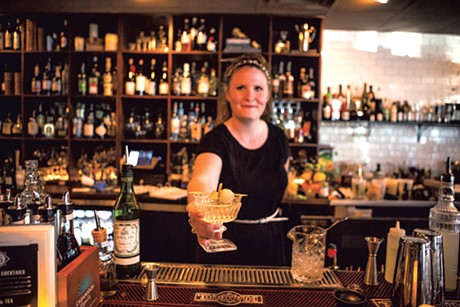
Nature’s Golden Ratio
Cocktails are maple trees… hear me out…
The perfect cocktail is sculpted with the perfect golden ratio, and perfect golden ratios are found in the branches of maple trees. Nature’s golden ratio is a proportion (approximately 1:1.61) that occurs frequently on earth and is used all over human endeavors such as art, architecture, and website design. Its visual representation nearly perfectly lines up with the Fibonacci sequence. When you arrange the sequence in a visual way, it creates a never-ending spiral that is reminiscent of a ram’s horn. This spiral can be found all over nature including in our weather patterns, the arrangement of seeds in a sunflower, structure of a pinecone, petals on a flower, and conveniently the branches and buds on a maple tree.
From trunk to arm to bough to branch to every bud on the maple tree, the golden ratio abounds. Fibonacci’s spiral and the golden ratio are balance, visual appeal, and contentment. When you drink a cocktail, like a really good cocktail how do you feel? Content. When you see that cocktail, how does it look? Visually appealing. And when you take that first sip, how does it taste? Perfectly balanced. And balance brings us back to the cocktail golden ratio.
The Golden Ratio of Cocktails
What sets a really wonderful cocktail apart from a really average cocktail is balance. A cocktail must be boozy, but not overpowering, sweet, but not too sickly, and savory, but not too much. Those components started very basically with whisky, sugar, and bitters, and has evolved through time to become quite complicated indeed. In our globalized world we can use miso paste, exotic fruits, spirits from the hills of Bolivia, and manufactured mists flavored with the scent of roasted marshmallow. For the purposes of the cocktail golden ratio, it’s important to start at the beginning.
The cocktail I just referenced with whisky, sugar and bitters you may recognize as the Old Fashioned. The Old Fashioned was originally just called “the cocktail” as it was the first time in recorded bar recipes where three ingredients were combined to create a stand-alone alcoholic drink. Bartenders of the day eventually made more three ingredient beverages following the balance of “the cocktail”- think Daiquiri, Gimlet, Manhattan- forcing patrons wanting whisky, sugar, and bitters to order “the Old Fashioned Cocktail”. Today using fresh juices, pure sugars, and quality spirits to interpret the golden ratio will make the most balanced cocktail.
The Golden Ratio: Sour Cocktails
The Old Fashioned started things off using 3 distinct ingredients, but the golden ratio was born of its offspring. Sour cocktails include citrus juice and are nearly always shaken vigorously to best emulsify, chill, and aerate the ingredients. To follow the Fibonacci of bartending, a golden ratio sour cocktail must include 2 parts something alcoholic, 1 part something sour, and .75-1 part something sweet.
The sweet ratio differs between .75 and 1 part in a sour cocktail based on the drinker’s taste, and the other ingredients in the drink. Bottled or Shelf Stable citrus is less flavorful, and more citric acid-forward than fresh juice. When using bottled juice generally use the 2:1:1 ratio to counter act the extra acidity presented in the citrus ingredient. Granulated sugar should not be used in sour cocktails, as the process of shaking does not dissolve sugar crystals effectively. Simple syrup made with a 1:1 ratio of white or demerara to water, or natural sugar syrups like maple, honey, or agave diluted 2:1 with water are preferred (water helps make the natural syrup thinner, thus easier to pour and emulsify). Because natural sugar syrups often carry their own stand-alone flavor, you often need less of them in a cocktail!
Examples of classic sour cocktails are the Daiquiri and Whisky Sour, with slight variations for a Maple Sour, Margarita and French 75. A Daiquiri and Whisky Sour are all traditionally made with simple syrup (1:1) but their differences come in type of alcohol and citrus: Daiquiri- rum & lime, Whisky Sour- whisky & lemon. Each is based in the 2:1:1 golden ratio, and each is strained “up” into a cocktail glass. Want to serve them on the rocks? Shake less vigorously so the cocktail won’t over dilute while the rocks melt. Garnishing with a piece of citrus? Consider a thinly sliced wheel or twist over a wedge. Wedges encourage the drinker to squeeze that extra bit of citrus into their cocktail, therefore throwing off your perfectly considered golden ratio!
Maple Sour is a great example of a variation of sugar syrups. It is made with Runamok Maple Sugarmaker’s Cut Syrup (in a 2:1 syrup) as the sweet ingredient. Maple adds a distinct flavor as well as sweetness and can be subbed in the same quantity as a typical simple syrup because it is slightly less sweet than white sugar. An example of variating a variation would be using the Runamok Makrut Lime-Leaf, Ginger Root, Elderberry or Hibiscus Infused Maple Syrup in your Maple Sour to add a little more excitement.
The Margarita’s sweet ingredient is orange liqueur. Some drinkers prefer .5 part agave syrup (2:1) to be added as well for more sweetness! Due to changing tastes and bar going experience during the 1970’s and 1980’s, the Margarita took a spiral down into the blender. Blending adds more ice and therefore more dilution, so the other ingredients have to make up for that imbalance. In the case of a Margarita, citric acid was added to citrus juice to make even more sour “sour mix”, and the drink was loaded up with sugary syrups and fruit flavors. Blending also hides the spirit flavor in a cocktail which could explain many an accidental hazy night.
A French 75 is a Gin Sour with sparkling wine on top. In a French 75, the quantity of gin must be reduced to make up for the alcoholic nature of the sparkling wine being added to it. In quite the opposite phenomenon of the blended Margarita, the lemon juice and simple syrup are also reduced to maintain the golden ratio. If a Gin Sour’s 2:1:1 ratio equates to 2 oz of gin, 1 oz lemon, 1 oz simple syrup, a French 75 could reduce to 1.5 oz of gin, .75 oz lemon, a scant .5 oz simple syrup all topped with sparkling wine.
The Golden Ratio: Aromatic Cocktails
At this point in our investigation, Fibonacci may have called it quits. Citrus, maple, and the agaves harvested for tequila grow encrypted with his spiral, but lest he forget the pleasure of drinking an aromatic cocktail. Aromatic cocktails nearly never include citrus juice, often include far less sugar, and include a bitter or savory ingredient. They should be stirred smoothly in a glass, as they need to be emulsified and chilled, but never aerated. All should be served strained over fresh ice in a rocks glass or up in a cocktail glass. Aromatics are largely just spirits and therefore are more fragile and delicate than citrus and sugars. There are fewer variations for Aromatics, but the four we will cover are very distinct. For this reason, we will not refer to the aromatic ratio as “golden” because the four ratios are far to nuanced to follow one model. Much like the Old Fashioned, the aromatic ratio is anchored by spirit, sweet, and savory. Usually 2:1:2, but this ratio is not in parts. I shall explain.
Let’s begin with some more detail on the Old Fashioned: traditionally 2 parts American Bourbon Whiskey, 1 sugar cube or 1 barspoon of simple syrup, and 2+ shakes of Aromatic bitters. The Old Fashioned was commonly garnished with both an expressed lemon and orange peel, but as we learned from the Margarita and Daiquiri, the mid 20th Century had other ideas. Somewhere along the line the Old Fashioned was augmented with sliced orange and red maraschino cherries muddled in with the sugar and bitters. Then, instead of stirring, a splash of water was added alongside ice and served. Debates will go down in history to what the “actual” recipe is for an Old Fashioned, and answers often differ between generations. Whisk(e)y variety can change or be subbed for rum or añejo tequila, sub Runamok Infused Maple Syrups for sugar, bitter flavors can change, but the particular balance of 2:1:2+ should not.
Second, the Manhattan is traditionally 1 part rye whisky, 1 part fresh sweet vermouth and 2+ shakes of aromatic bitters. The Manhattan is served up in a cocktail glass, garnished with an expressed orange peel or a Luxardo cherry whose rich flavor compliments the sweet vermouth. For a Maple Manhattan, substitute the Sweet Vermouth for ¾ part Runamok Bourbon or Rye Whiskey Barrel Aged Maple Syrup syrup (2:1), and add 2 more shakes of bitters. Barrel aged maple syrup adds sweetness of course, but also a distinct caramel, oak nuttiness to the flavor.
Third, a Martini. Traditionally one stirs together (why Ian Fleming?!) 2 oz gin, 1 oz fresh French dry vermouth, and 2 dashes of orange bitters. The Martini is strained into a cocktail glass and garnished with an expressed lemon. Always use fresh vermouths in Manhattan’s or Martinis, or ones stored in the fridge. Since they are largely wine, they will go bad after a few days if left out. This could explain why Dirty and Bone Dry martinis became popular in the late 20th century. After all, no one wants spoiled vermouth in their aromatic cocktail.
The final aromatic ratio variant is the Negroni with a standard ratio of 1:1:1- gin, sweet vermouth, and bitter liqueur. In the Negroni all ingredients are spirits, but all three fulfill two categories in the spirit, sweet, bitter foundations of an aromatic ratio. Because everyone on team Negroni works two jobs, it is unnecessary to add additional sugars, citrus, or bitters. The Negroni is always stirred gently, strained into a rocks glass filled with ice, and garnished with an expressed orange peel. The bitter liqueur used is often a red bitter like Campari or Aperol, so the negroni is bright red and recognizable on a bar top.
The Negroni is also the most representative of Fibonacci’s balance, visual appeal, and contentment. It has a 1:1:1 golden ratio, looks distinctly red and delicious, and gives the drinker a subtle feeling of being on the Italian coast. But what about all other cocktails not mentioned in this dive into golden ratios? Many modern popular cocktails are twists on one of the classic “goldens” listed in this piece. They double up on base spirits, use savory syrups and juices, have ingredients playing to several tastes at once, or even use ingredients not available pre-20th century. What every good cocktail- be modern or classic- has in common, is it should be balanced. It should taste of all things evenly, look fantastic in the correct glass and garnish, and give the drinker a profound sense of contentment- like walking through a forest. A forest of maple trees with balanced and visually appealing limbs. Waiting to be tapped, sap-ed and boiled into sweet syrup. Because after all, cocktails are maple trees.
